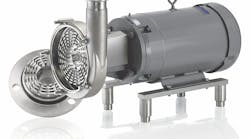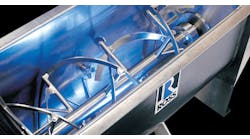Batch vs. continuous is one of the most basic choices in process design. It especially applies to one of the most basic operations: mixing and blending.
As an alternative to being blended in a tank or other vessel, liquids can be blended with other liquids, or with powders and other solids, directly inside the pipeline that will carry them to filling or whatever is the next step in the process. This can be done with moving parts like rotors, or with static structures that blend liquids together by forcing them through tortuous paths.
In-line operation can be a very efficient way to mix products and keep them moving toward fillers. But as with many aspects of production, what’s gained in efficiency is often lost in flexibility. And in-line mixing is not suitable for certain applications due to performance issues.
The number of ingredients in a formulation often determines whether in-line mixing is an option. If there are a lot of ingredients that often vary, batch mixing may be the best option; in-line systems aren’t good at handling excessive complexity.
“If I have a customer that has a product with only four ingredients, that’s a process that only requires four streams, four pumps, four meters, four tanks,” says Greg Collier, president of the St. Louis division of Statco-DSI. “If I have a customer that has eight ingredients, and also from brand to brand they change quite drastically – in those cases it can make little sense to design a system that has 12 to 14 streams on it just to produce a mixture of four to five products.”
Sometimes in-line mixing is applied for a mundane reason: space. In-line systems can generally handle the throughput of a batch blender in a fraction of its space, which can be a deciding factor, especially in plants with low ceilings. In other cases, a batch blender may not quite get all ingredients completely mixed; an in-line system can finish the job by further mixing the discharge from the batch tank.
Consistency in motion
One of the biggest advantages of in-line mixing is that, when configured properly, it tends to give more consistent results than batch mixing. This is especially true in applications that require one of the components to be greatly reduced and dispersed, such as emulsions for products like margarine.
“With the mill, in particular, what we can do in terms of droplet sizes on emulsions or particle size reduction for hard particles, is greater than what could be done in an in-tank mixer,” says Patrick Lakin, national sales and technical service manager for Admix Inc., supplier of the Boston Shearpump.
Gums and thickeners are among most challenging things to mix, because they’re often hard to get completely wet.
This high-shear mixer from Ross Mixers features S.L.I.M. (Solid-Liquid Injection Manifold) technology for hard-to-mix gums and thickeners.
“These ingredients are usually difficult to disperse because they tend to form lumps (known as ‘fisheyes’), which are dry at the core and hydrated and somewhat sealed on the outer layer,” says Ken Langhorn, vice president of sales for Ross Mixers. “Fisheyes can take a long time to disperse and fully hydrate once they form.” Ross has a line of in-line mixers with technology, called Solid-Liquid Injection Manifold (S.L.I.M.), especially designed for such applications.
More generally, Langhorn says, “Inline mixers can also be fit neatly into a process pipeline that already involves a transfer step. In this application, the product quality is improved as the material is pumped from one location in the plant to another.”
Moving it along
Getting the material from one location to another more easily is, in fact, an advantage of in-line mixing. An in-line mixer not only saves time over batch mixing; it creates, for some applications, force that helps move the product along. Ross’ in-line high shear mixer will generate flow and moderate discharge pressures for liquids with viscosities up to 20,000 centipoise (about the consistency of chocolate syrup).
However, there are limitations on how well in-line mixing can serve as a pump. If liquids are too viscous, the mixing action alone won’t be enough to move them. In any case, the more pumping action a mixer provides, the less mixing intensity it yields, says Joby Ferary, manager of North American sales for Axiflow Technologies. “If you want pumping action out of a mixer, you’re going to lose mixing intensity,” he says.
The basic dilemma is that the way to generate pumping action in an in-line mixer is to angle the teeth of the rotor outward, toward the product flow, but doing so diminishes the force it applies to the product.
In some cases, the shear force generated by an in-line mixer simply won’t be enough by itself to keep product moving, Ferary says. “If you have a truly high-shear mixer, the best pumping capability you will get out of that mixer [is that] it would function as a very inefficient centrifugal pump,” he says. “It cannot perform a positive displacement pump duty.”
Rotor-stator configurations are available to handle different viscosities, flow rates and other parameters. Photo: Fristam Pumps
It all comes down to viscosity. There are some in-line mixing systems that can function as centrifugal pumps, and they can handle liquids that are low enough in viscosity to pass through a centrifugal pump, like the FSI Shear Pump from Fristam Pumps.
“We would size the FSI the same as other centrifugal pumps, and as a standalone pump it has the same viscosity limitations as a centrifugal pump,” says Dan Osiedacz, mixing and blending products manager for Fristam. When liquids are too viscous to be pumped just through the shear force of the mixer alone, they need pumps, usually positive-displacement ones, either before or after the mixing segment, or both.
Getting residence right
Whatever the product viscosity, one of the most important aspects of designing a mixing system is fine-tuning the product residence time. This is considerably more challenging for in-line than for batch mixing because of its continuous nature.
Getting the residence time right depends in large part on properly sizing the pipeline and all components. This is mostly a matter of experience, as well as trial and error. It helps if a supplier has a well-equipped pilot facility that can test various configurations.
“For shearing applications like emulsions we have sizing charts that can get the customer to a good starting point regarding the model of [shearing device], the flow rate of the product, the rpm of the blender and the rotor-stator type we choose,” Osiedacz says. “From there the customer will make adjustments to rpm and/or flow rate to achieve the desired shearing.”
In most applications, optimal mixing means varying both the flow rate and the speed of the mixer – the rotor that turns inside the pipe and does the actual mixing. This means that the motor that powers the rotor needs to operate at variable speeds; the same is often true of the pumps that push product in and/or draw it out. Since these are almost always AC motors, that requires variable-frequency drives.
“We certainly use VFDs which, changing the output speed of the mill or the pump, can give you different results coming out,” Lakin says. “There’s more intense mixing, obviously, at higher speeds.”
Getting the right flow rates in the proper sequence, along with releasing components at the right times in the right amounts, all must be carefully coordinated. This is why the VFDs and other components of an in-line mixing system are usually run though a programmable logic controller (PLC). In most cases, the PLC resides in the cart or skid that holds the mixing system and is connected upstream and down as needed.
Collier estimates that in nine out of 10 installations, Statco-DSI furnishes VFDs, motor starters and other required controls on the system’s skid. Occasionally, customers have their own PLCs and other controls in place, operated from control cabinets, and want the controls for the mixing system to reside in those cabinets.
“In those instances, we can go in and make the controls [for the mixing system] part of the existing system,” he says. “It’s just more of a rarity for us to do that because in the end, most of the time, it injects a fair amount of risk to have stuff [in a space] that’s occupied by other equipment.”
In-line mixing can provide more consistent results, in less space, than batch mixing. But it’s not a panacea, and must be carefully reviewed to ensure that it’s right for a given application.


